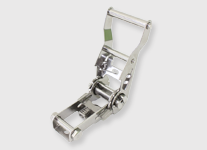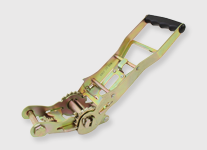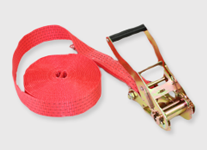For professional cargo securing on trucks, cars, trailers and transports using lashing straps, there are many different versions of ratchets for normal and heavy-duty use, in stainless steel and even as fully galvanised versions.
 Ratchet for lashing straps
Ratchet for lashing straps
 Long-lever ratchet for lashing straps
Long-lever ratchet for lashing straps
 Single-part ratchet lashing strap
Single-part ratchet lashing strap
A distinction is made between three main groups:
- Long-lever ratchet
- Short-lever ratchet
- Heavy duty ratchet
In addition, there are three further categories according to the direction in which the force is applied:
- Push ratchet / push ratchet / pressure ratchet
- Pull ratchet
- Multi-ratchet (push & pull)
The long-lever ratchet
This ratchet is a type of pull ratchet, which means that it is pulled downwards when actuated. This achieves a significantly higher force transmission than is the case with impact ratchets and increases the achieved pretensioning force many times over. Their handling is considered particularly ergonomic for the user. Like other means of cargo securing, they are subject to regulations: according to EN 12195, they must be able to provide pre-tensioning forces of 450 to 550 daN. EN 12195-2 also stipulates that bent, severely corroded or non-functional ratchets must no longer be used.
The short-lever ratchet
This ratchet is also known as a pressure ratchet and is pressed upwards when actuated, which is why its pre-tensioning force is not as great as that of a long-lever ratchet. According to EN 12195, it also has to provide certain pre-tensioning forces: from 120 to 350 daN. To prevent the lashing strap from having to be discarded, the range for exclusion from EN 12195-2 also applies to it.
First you have to thread the strap end of the long end into the winding shaft of the ratchet. When the ratchet lever is attached, the rotary movement of the shaft winds up the strap and tightens it.
For a tight fit of the belt, at least 1.5 turns of the lashing strap must be applied to the winding shaft. Attention: No more than three belt layers may be wound up, otherwise the locking slider may jam.
To release the strap, pull the function slider and swivel the ratchet lever approx. 180 degrees against the stop. Attention: The pre-tensioning force is released abruptly, which is why the load must be checked for possible danger beforehand.
 Auswahl im Warenkorb
Ab 120,00 € Bestellwert
Auswahl im Warenkorb
Ab 120,00 € Bestellwert